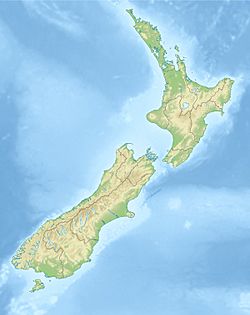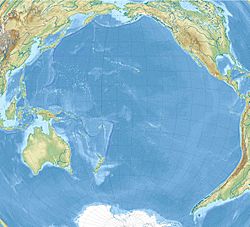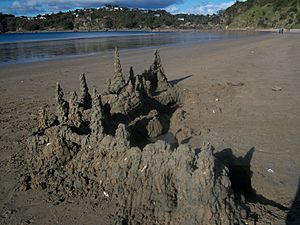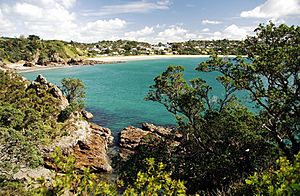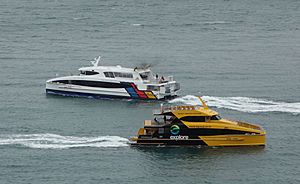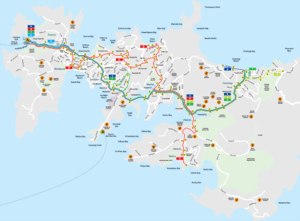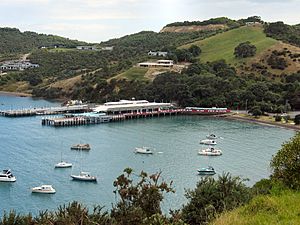Waiheke Island facts for kids
|
Waiheke (Māori)
|
|
|---|---|
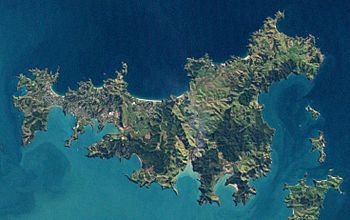
Landsat image of the island, August 2002
|
|
| Geography | |
| Location | Hauraki Gulf |
| Coordinates | 36°48′S 175°06′E / 36.800°S 175.100°E |
| Archipelago | New Zealand archipelago |
| Area | 92 km2 (36 sq mi) |
| Length | 19.3 km (11.99 mi) |
| Width | 0.64–9.65 km (0.40–6.00 mi) |
| Coastline | 133.5 km (82.95 mi) |
| Highest elevation | 231 m (758 ft) |
| Highest point | Maunganui |
| Administration | |
|
New Zealand
|
|
| Regional Council | Auckland Region |
| Demographics | |
| Demonym | Waihekean |
| Population | 9,420 (June 2023) |
| Pop. density | 102.4 /km2 (265.2 /sq mi) |
| Ethnic groups | European, Māori |
Waiheke Island (/waɪˈhɛkiː/; Māori: [ˈwaihɛkɛ]) is a beautiful island in New Zealand. It is the second-largest island in the Hauraki Gulf. Only Great Barrier Island is bigger.
Waiheke is about 21.5 kilometers (13.4 miles) from Auckland city. It is the most populated island in the Hauraki Gulf. Many people live here all year round. About 3,400 more people have holiday homes on the island.
Waiheke is easy to get to. There are regular ferries for people and cars. You can also fly there by helicopter or other small planes. In 2015, Lonely Planet called Waiheke Island one of the best places in the world to visit.
Contents
Exploring Waiheke Island
Island Shape and Size
Waiheke Island is located off the coast of the North Island. It is 19.3 kilometers (12 miles) long from west to east. The island's width changes a lot, from 0.64 kilometers (0.4 miles) to 9.65 kilometers (6 miles). Its total area is 92 square kilometers (35.5 square miles).
The coastline of Waiheke is 133.5 kilometers (83 miles) long. This includes 40 kilometers (25 miles) of beaches. The island is very hilly, with only a few flat areas. The highest point is Maunganui, which is 231 meters (758 feet) high.
Island Rocks and Land
Geologists find some interesting rock formations on Waiheke. There is a type of rock called argillite in Rocky Bay. Also, there is a tall stack of chert rock at Pohutukawa Point. These are great examples of folded rock layers.
Beautiful Beaches
Waiheke Island has many lovely beaches. Here are some of the most popular ones:
- Oneroa Beach – This is the main beach in the town of Oneroa.
- Little Oneroa Beach – A small, quiet beach next to Oneroa Beach.
- Palm Beach – This beach is named after the tall palm trees at its eastern end.
- Little Palm Beach – A small, clothes-optional beach at the west end of Palm Beach.
- Blackpool Beach – This beach faces south and is popular for kayaking and windsurfing.
- Surfdale Beach – Located on the southern side of Surfdale. It is a good spot for kitesurfing.
- Onetangi Beach – This beach is 1.87 kilometers (1.16 miles) long. It faces north and is famous for its annual Onetangi Beach Races. It also hosts sandcastle building contests.
- Cactus Bay – Many locals think this is the most perfect beach. It is only reachable by boat or kayak.
- Shelly Beach – A small, calm beach between Oneroa and Ostend. It has free BBQ areas and a diving platform. It's great for families.
Waiheke's Weather
Waiheke Island has a warm, mild climate. Summers are usually warm and humid. Winters are not very cold, and it rarely snows or freezes.
The island usually gets plenty of rain. However, sometimes there are dry periods in summer. Most homes on Waiheke collect rainwater from their roofs for drinking and daily use. During dry times, water trucks deliver water to homes that run out.
Locals often say Waiheke has its own special weather. It gets over 100 more hours of sunshine each year than other parts of Auckland.
| Annual Mean Temperature | Annual Precipitation | Annual Sunshine Hours |
|---|---|---|
| 15.2c | 1461mm | 2100 |
Island History
The original Māori name for Waiheke was Te Motu-arai-roa. This means "the long sheltering island." Later, when the first Europeans arrived, it was known as Motu-Wai-Heke. This means "island of trickling waters."
Who Lives on Waiheke?
Island Population
Waiheke has a population of 9,162 people (as of 2023). Most people live near the western end of the island. The main towns are Oneroa, Blackpool, Palm Beach, Surfdale, and Ostend. Further east is Onetangi. The eastern half of the island has many farms and vineyards.
Waiheke is a very popular holiday spot. During summer and holidays like Christmas and Easter, the population grows a lot. Many holiday homes are rented out, and there are festivals and events. The island becomes very lively and festive.
People and Cultures
| Ethnicity | Population |
|---|---|
| New Zealand European |
8,061
|
| Māori |
1,125
|
| Pasifika |
333
|
| Asian |
417
|
| MELAA |
471
|
| Other |
96
|
| Historical population | ||
|---|---|---|
| Year | Pop. | ±% p.a. |
| 2006 | 7,797 | — |
| 2013 | 8,340 | +0.97% |
| 2018 | 9,063 | +1.68% |
| 2023 | 9,162 | +0.22% |
In the 2023 census, Waiheke's population was 9,162. This was a small increase from 2018. The average age of people on Waiheke was 49.1 years. About 13% of the people were under 15 years old.
Most people on Waiheke are of European descent (88%). About 12.3% are Māori. Other groups include Pasifika, Asian, and people from the Middle East, Latin America, and Africa. Many people (32%) were born outside New Zealand.
How Waiheke is Governed
Waiheke is part of the Auckland Council. The island used to have its own local government called the Waiheke County Council. In 1989, it joined the Auckland City Council.
Today, Waiheke has its own elected community board. This board helps represent the island's people. In 2010, when the larger Auckland Council was formed, Waiheke was given its own local board. This means local residents have a say in how their island is run.
Island Life and Fun
Arts and Culture on Waiheke
Waiheke has a lively arts and culture scene. There is a community-run cinema and a theatre for music and shows. The island also has a modern library. Many private art galleries are spread across the island, along with a community art gallery.
Every two years, Waiheke hosts a famous event called Sculpture on the Gulf. This is an outdoor sculpture exhibition along a beautiful coastal path. It attracts thousands of visitors and has been recognized internationally.
Sports and Activities
Waiheke has many sports teams and facilities. Popular sports include rugby union, cricket, rugby league, football, and netball.
There are three main sports areas on the island:
- Onetangi Sports Park: This park is home to the Waiheke Tennis club, Waiheke United AFC (football), Waiheke Rugby, Waiheke Cricket, and a mountain bike club. It also has an 18-hole Frisbee (Disc) Golf course.
- Ostend Sports Park: Located in the middle of the main towns. It is home to the Waiheke Rams rugby club and the Waiheke Dolphins netball teams.
- The Waiheke Recreation Centre: A large indoor sports center. It is used by the High School during the day. In the evenings and on weekends, it offers activities like badminton, basketball, gymnastics, and martial arts.
Learning on Waiheke
Waiheke Island has two primary schools and one secondary school. It is special because it's one of the few islands in New Zealand (besides the main North and South Islands) that has a high school.
In 2016, the New Zealand Government announced a big project to rebuild schools on Waiheke. This included $23 million for Te Huruhi School and $17 million for Waiheke High School. The goal was to build new classrooms and improve existing buildings.
- Te Huruhi Primary School is for students in Years 1–6. It is located in Surfdale.
- Waiheke Primary School is for students in Years 1–8. It is located in Ostend.
- Waiheke High School is for students in Years 7–13. It is located in Surfdale.
Getting Around Waiheke
Ferry Services
Ferries are the main way to travel to and from Waiheke. The journey from Auckland city takes about 40 minutes.
- Fullers operates passenger ferries from Downtown Auckland to Matiatia wharf on Waiheke.
- SeaLink provides services for passengers, cars, and freight. They travel between Half Moon Bay (East Auckland) and Kennedy Point on Waiheke. This trip takes about 50 minutes to an hour. SeaLink also has a "City Service" from Kennedy Point to Auckland's Wynyard Quarter.
Many Waiheke residents rely on the ferries for daily travel, especially those who work in Auckland. There have been discussions about improving ferry services and parking at Matiatia.
Bus Network
Waiheke has a public bus service run by Waiheke Bus Company. It is managed by Auckland Transport.
There are five bus routes that started in October 2019. Most routes connect to the Matiatia ferry terminal. They spread out across the island to places like Palm Beach, Ostend, Rocky Bay, and Onetangi Beach. There are no public bus routes in the far eastern part of the island.
- 50A – Onetangi Beach West, Ostend, Surfdale, Oneroa, Matiatia Ferry Terminal
- 50B – Onetangi Beach East, Ostend, Surfdale (Jellicoe Parade, Wellington Road), Oneroa, Matiatia Ferry Terminal
- 501 – Kennedy Point Wharf to Matiatia Ferry Terminal
- 502 – Ōmiha (Rocky Bay), Ostend, Palm Beach, Blackpool, Oneroa, Matiatia Ferry Terminal
- 503 – Matiatia Ferry Terminal to Oneroa (one-way summer service)
Bus fares are flat, meaning they cost the same no matter how far you travel on the island. In 2019, it was announced that Waiheke would get electric buses starting in 2020.
Air Travel
Waiheke has one airport, Waiheke Island Aerodrome. You can also reach the island by a regular seaplane service.
Island Infrastructure
Waiheke Island has less infrastructure than mainland Auckland.
- Roads: Many roads are narrow and not sealed (paved), especially in the eastern part of the island. The speed limit is usually 50 km/h (31 mph). A sign at the car ferry terminal says "Slow Down, You're here" to remind visitors about the island's relaxed pace.
- Transport: Most people use their own cars or rental cars. The Waiheke Bus Company connects to the ferry services. Taxis, shuttles, and other services are also available. Bicycling is popular, especially with the rise of electric bikes (ebikes). Walking is also a great way to get around and explore the island's many trails.
- Power: Waiheke gets its electricity from the North Island through underwater cables.
- Water and Waste Water: Most houses collect rainwater in tanks for their water supply. Water delivery trucks are busy during dry summers. Most homes also have septic tanks for sewage.
- Internet: A fiber optic cable connects Waiheke to the internet. Wireless internet is also available.
- Solid Waste: The island has a successful recycling center.
- Emergency Services: The Waiheke Volunteer Fire Brigade has two stations on the island.
- Media: Waiheke has a local newspaper, the Waiheke Gulf News. There is also a community radio station, Waiheke Radio, broadcasting on 88.3 FM and 107.4 FM.
Matiatia Ferry Terminal
Matiatia is the main ferry terminal on Waiheke. Over one million passengers arrive here each year. In the past, there were plans to build a large shopping and hotel complex here. However, local residents formed a group called the Community and People of Waiheke Island (CAPOW) to oppose it. They wanted to protect the natural beauty of the area.
After a long process, the Auckland City Council bought the land in 2005. This meant the large development plans were stopped. The community worked together to keep Matiatia special. In 2013, there was another discussion about building a private marina at Matiatia. Again, residents spoke up, and the plan was not approved.
Waiheke's Famous Wines
Waiheke is known as New Zealand's "island of wine." Many dedicated winegrowers here grow special grapes. The island's climate and soil are perfect for growing certain types of grapes. These include Bordeaux-style grapes, Chardonnay, and Sauvignon blanc. Waiheke is also famous for its Syrah wines. For example, Kennedy Point's 2007 Syrah was named the best Syrah in the world in 2009!
Wines from Waiheke can be quite expensive. This is because the vineyards are often small, and they produce unique, high-quality wines.
Here are some of the vineyards and wineries on Waiheke Island:
- Awaroa Vineyard – Grows Syrah and Cabernet Sauvignon.
- Batch Winery – Waiheke's newest winery, located at the highest vineyard.
- Cable Bay Vineyards – Makes wines from grapes grown on Waiheke and in Marlborough.
- Destiny Bay Vineyards – Specializes in Cabernet blends.
- Edbrooke Vineyard – Grows Merlot, Cabernet Franc, Chardonnay, and Pinot gris.
- Eventide Vineyard – A small vineyard producing Syrah.
- Fenton Estate – First planted in 1989.
- Goldwater Estate – One of the first wineries on Waiheke.
- Jurassic Ridge – A family-owned vineyard named after the local geology.
- Kennedy Point Vineyard – The only certified organic vineyard on Waiheke.
- Man O' War – Located at Man O' War Bay, with vineyards on a large farm.
- Miro Vineyard – Produces red Bordeaux blends.
- Mudbrick Vineyard – A well-known winery with a restaurant made of mudbrick.
- Obsidian Vineyard – Known for its flagship wine, Obsidian, a blend of several grapes.
- Passage Rock Wines – Located at the eastern end of Waiheke Island.
- Peacock Sky – Has views across the Hauraki Gulf to Auckland.
- Peninsula Estate – Planted in 1986/87.
- Postage Stamp Wines
- Poderi Crisci Estate
- Stony Batter Estate – The island's largest vineyard.
- Stonyridge Vineyard – Famous for its Bordeaux-style reds, especially Stonyridge Larose.
- Tantalus Estate
- Te Motu Vineyard – Established in 1989.
- Te Whau Vineyard
- The Hay Paddock – A vineyard planted with Syrah vines.
- Topknot Hill Vineyard
- View East Vineyard – Specializes in Syrah.
- Woodside Hill – Specializes in Merlot and Cabernet Franc.
See also
 In Spanish: Isla Waiheke para niños
In Spanish: Isla Waiheke para niños


